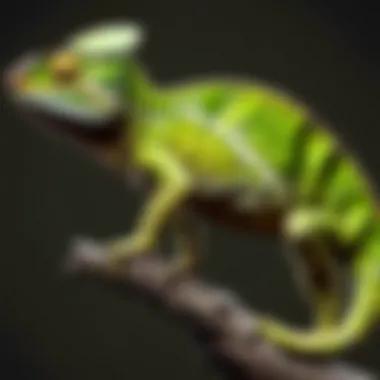Unveiling the Intriguing Realm of Reptiles: A Comprehensive Guide


Character Profiles & Movesets
Reptiles are a diverse group of cold-blooded vertebrates that encompass fascinating creatures such as snakes, lizards, turtles, and crocodiles. Each reptile species boasts unique adaptations and behaviors that have allowed them to thrive in various environments across the globe. From the camouflaged scales of chameleons to the venomous strikes of cobras, exploring the world of reptiles unveils a myriad of intriguing characteristics and survival strategies.
Gameplay Strategies & Tactics
When delving into the realm of reptiles, it is essential to understand the habitat preferences and dietary habits of each species. Some reptiles, like the desert-dwelling Gila monster, have adapted to store water and can go extended periods without consuming food. In contrast, aquatic reptiles such as sea turtles are expert swimmers, maneuvering gracefully through ocean currents in search of prey. Understanding these behavioral patterns is crucial for appreciating the diversity and complexity of reptilian life.
Storyline & Lore Explorations
The evolution and enigmatic history of reptiles date back millions of years, showcasing their resilience and tenacity as a group. Through paleontological discoveries and genetic studies, scientists have unveiled the intricate evolutionary pathways that have shaped modern-day reptiles. From the formidable Tyrannosaurus rex to the agile geckos, each reptilian lineage contributes a unique chapter to the enthralling narrative of our planet's biological history.
Updates & Patch Notes
As the study of reptiles continues to evolve, researchers uncover new insights into their physiology, behavior, and ecological roles. Recent findings shed light on the intricate sensory capabilities of snakes, revealing how they detect heat signatures with unparalleled precision. Additionally, conservation efforts strive to safeguard threatened reptile species from the brink of extinction, emphasizing the critical importance of preserving the biodiversity of our natural world.
Understanding Reptiles
When delving into the captivating realm of reptiles, it is essential to grasp the intricacies that define these fascinating creatures. Understanding reptiles is not merely about acknowledging their existence but about unraveling the evolutionary path that has shaped their unique characteristics. By shedding light on the defining traits of reptiles, we gain insight into their role in the natural world and appreciate the diversity they bring to ecosystems. This exploration serves as a gateway to appreciating the wonders of reptilian anatomy, behavior, and ecological significance.
Defining Reptiles
In discussing the definition of reptiles, we are drawn to their classification as cold-blooded vertebrates characterized by scales, laying amniotic eggs, and having lungs for respiration. This distinct taxonomic group includes various species like snakes, lizards, turtles, and crocodiles, each with its adaptations to thrive in different environments. Understanding what makes an animal a reptile is fundamental in appreciating their biological functions and phylogenetic relationships with other wildlife.
Evolutionary History
Embarking on a journey through the evolutionary history of reptiles unveils the ancient roots from which these creatures have evolved. By exploring the lineage of reptiles from their Mesozoic ancestors to their modern-day descendants, we can appreciate the adaptations that have allowed them to survive and diversify over millions of years. Understanding the evolutionary trajectory of reptiles provides a context for their current ecological roles and helps us comprehend the biological innovations that have shaped their existence.
Ancient Reptilian Ancestors


Delving into the ancient reptilian ancestors offers a glimpse into the prehistoric world where reptiles first emerged. These ancestral reptiles such as early archosaurs and primitive turtles showcase pivotal adaptations like the development of hard protective shells and specialized teeth for their dietary needs. Their legacy contributes to the genetic heritage of modern reptiles, highlighting the resilience and evolutionary success of these ancient creatures.
Key Adaptations
Exploring the key adaptations of reptiles reveals the remarkable strategies they have developed to thrive in diverse habitats. From the evolution of scale patterns for camouflage to physiological adjustments for efficient thermoregulation, reptiles have honed specific traits that enhance their survival chances. Understanding these key adaptations offers valuable insights into the ecological niches reptiles occupy and the evolutionary pressures that have shaped their biological diversity.
Distinctive Features
The distinctive features of reptiles, such as their scaly skin and cold-blooded nature, set them apart from other animal groups and define their physiological characteristics. These adaptations have enabled reptiles to conquer various environments, from arid deserts to lush rainforests, showcasing their versatility and resilience in the face of environmental challenges.
Scales and Skin
Reptiles' scales and skin serve crucial functions, providing protection from external threats and minimizing water loss in arid conditions. The diversity in scale patterns among different reptile species reflects their evolutionary history and environmental adaptations. Understanding the role of scales and skin in reptiles offers a window into their evolutionary success and biological exceptionalism.
Cold-Blooded Nature
Reptiles' cold-blooded nature, or ectothermy, means they rely on external heat sources to regulate their body temperature. This metabolic strategy influences their activity levels, feeding behavior, and choice of habitats, shaping their ecological interactions and evolutionary pathways. By acknowledging the significance of their cold-blooded physiology, we can appreciate the intricate balance reptiles maintain with their surrounding environments.
Diversity of Reptiles
The Diversity of Reptiles is a crucial section in this article as it delves into the wide array of reptile species present in the natural world. Understanding the different reptile groups is essential to grasp their unique adaptations and behaviors. By exploring the various types of reptiles, from lizards to snakes, turtles, and crocodilians, readers can gain a comprehensive insight into the evolution and survival strategies of these fascinating creatures. This section serves as a foundation for appreciating the complexity and beauty of reptilian diversity.
Lizards
Lizards play a significant role in the realm of reptiles due to their diverse characteristics and widespread distribution. Their ability to adapt to various environments and their curious behaviors make them a popular choice for study and admiration. One key characteristic of lizards is their varied coloration and body shapes, reflecting their ecological niche and evolutionary history. Despite their advantages in terms of habitat versatility, some lizards face challenges such as predation and habitat loss.
Snakes
The inclusion of snakes in this article highlights their importance in the ecosystem and their unique features as reptiles. Snakes are known for their limbless bodies and predatory nature, making them intriguing subjects for researchers and enthusiasts. The key characteristic of snakes lies in their ability to swallow prey whole, relying on their highly flexible jaws. While this adaptation is advantageous for hunting, snakes also face disadvantages such as vulnerability to environmental changes and human activities.


Turtles
Turtles represent a fascinating group of reptiles with distinctive shells and habits that contribute significantly to the diversity of reptiles. Their shell serves as a protective armor against predators, showcasing a remarkable adaptation in the reptile kingdom. The key characteristic of turtles is their ability to retract their head and limbs into their shell, providing a unique defense mechanism. Despite these advantages, turtles are susceptible to habitat destruction and accidental catch in fishing activities.
Crocodilians
Crocodilians encompass a group of large, aquatic reptiles that play a vital role in aquatic ecosystems. Their unique features, including powerful jaws and semi-aquatic lifestyles, set them apart from other reptiles. The key characteristic of crocodilians is their remarkable ability to regulate body temperature through basking and seeking shade. While their adaptability has ensured their survival for millions of years, crocodilians face threats from habitat degradation and illegal poaching.
Reptile Behavior and Ecology
Reptile Behavior and Ecology plays a vital role in understanding the complexities of the reptilian world. It offers valuable insights into how reptiles interact with their environment, hunt for prey, and reproduce. By analyzing behavior patterns and ecological preferences, researchers can gain a deeper appreciation for these fascinating creatures.
Habitat Preferences
Terrestrial Habitats
Terrestrial Habitats serve as crucial environments for numerous reptile species. The dry landscapes provide a prime setting for reptiles that thrive in arid conditions. With sparse vegetation and sandy substrates, Terrestrial Habitats present challenges and opportunities for reptiles to adapt and camouflage effectively. The vast expanse of deserts and semi-arid regions showcases the resilience of reptiles in these harsh environments.
Aquatic Environments
Aquatic Environments hold a different allure for reptiles, offering a diverse range of habitats such as swamps, rivers, and lakes. Reptiles that inhabit these areas have adapted to a semi-aquatic lifestyle, displaying unique behaviors like basking in the sun on riverbanks. The rich biodiversity of Aquatic Environments provides food sources and shelter for aquatic reptiles, contributing to their survival and reproductive success.
Feeding Patterns
Carnivorous Reptiles
Carnivorous Reptiles are skilled hunters that rely on a diet of meat for sustenance. Their predatory instincts and specialized adaptations make them efficient predators in their ecosystems. From snakes that inject venom to lizards with razor-sharp teeth, carnivorous reptiles exhibit a diverse range of feeding strategies honed through evolution.
Herbivorous Reptiles


Herbivorous Reptiles consume plant matter as their primary food source, utilizing specialized digestive systems to extract nutrients from vegetation. Their feeding habits play a crucial role in shaping plant communities and maintaining ecological balance. From tortoises browsing on succulent cacti to iguanas munching on leafy greens, herbivorous reptiles showcase the diversity of herbivory in the reptilian world.
Reproductive Strategies
Egg-Laying Species
Egg-Laying Species employ diverse reproductive strategies to ensure the survival of their offspring. By laying eggs in carefully constructed nests or burying them in substrate, these reptiles protect their eggs from predators and environmental factors. The incubation period and hatchling care differ among species, reflecting the adaptations required for successful reproduction.
Live-Bearing Species
Live-Bearing Species exhibit viviparity, giving birth to fully developed young instead of laying eggs. This reproductive strategy offers certain advantages, such as increased offspring survival rates and protection during early development. By nourishing their young internally, live-bearing reptiles ensure a higher likelihood of offspring reaching maturity in challenging environments.
Interaction with Humans
Reptiles have long been intriguing creatures with a complex relationship with humans. The interaction between reptiles and humans offers insights into coexistence and conservation efforts. Understanding the behaviors and habitats of reptiles is essential for fostering positive relationships and promoting biodiversity. Through responsible practices such as habitat preservation and wildlife protection, humans can minimize negative impacts on reptile populations and enhance ecosystem health.
Reptiles as Pets
Popular Pet Reptiles
Popular pet reptiles, such as bearded dragons and ball pythons, are favored for their unique characteristics and relatively low maintenance. These reptiles appeal to enthusiasts due to their docile nature and captivating appearances. They provide opportunities for educational outreach and scientific study while fostering respect and appreciation for wildlife.
Care and Maintenance
Taking care of pet reptiles involves providing appropriate habitats, diet, and environmental enrichment. Proper care and maintenance routines are crucial for the health and well-being of pet reptiles. Regular veterinary check-ups, temperature regulation, and dietary considerations all play a role in ensuring the longevity and happiness of pet reptiles.
Conservation Concerns
Conservation efforts are vital for addressing threats to reptile populations and their habitats. Habitat loss due to human activities such as deforestation and urbanization poses a significant risk to many reptile species. By implementing conservation strategies like protected areas and habitat restoration, we can safeguard reptile diversity and promote sustainable coexistence.
Habitat Loss
Habitat loss disrupts ecosystems and jeopardizes the survival of numerous reptile species. The destruction of natural habitats through land development and resource extraction undermines biodiversity and ecological balance. Mitigating habitat loss requires collaborative efforts from governments, organizations, and individuals to conserve critical habitats and restore degraded landscapes.
Illegal Wildlife Trade
The illegal wildlife trade remains a dire threat to reptile populations worldwide. Poaching and trafficking operations target vulnerable reptile species for commercial profit, leading to population declines and ecological imbalances. Combatting illegal wildlife trade demands robust law enforcement, enhanced regulation, and public awareness to curb illicit activities and protect imperiled reptile species.







